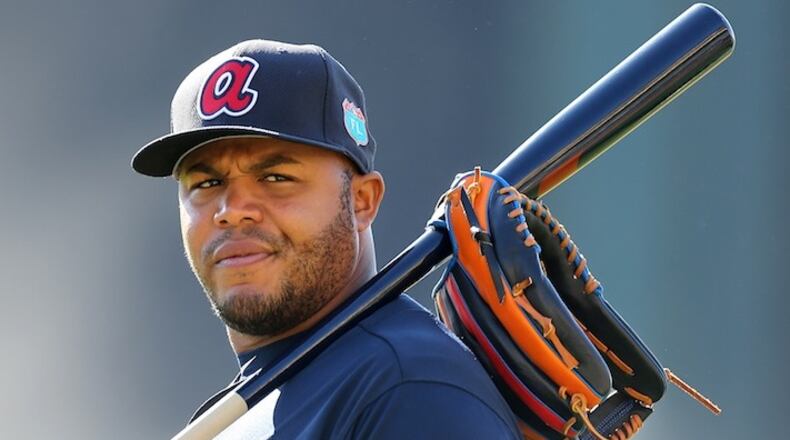It being January, this would be a fine time to assess offseason additions made by the 2021 world champion Braves. Here goes: In November, they acquired reliever Kirby Yates and catcher Manny Pina. That’s about it.
As for Freddie Freeman: If he re-signs with the Braves, that’ll be great; if he doesn’t, it will be less great. How’s that for cogent commentary?
Any further business? No? OK, we’re adjourned.
On Dec. 2, MLB locked out its players. No transactions involving a big-league player can be made until a settlement is reached. The sides have had one meeting. MLB made some sort of proposal. The players laughed and went ice fishing, or whatever it is baseball players do when not playing baseball.
The lockout turned team websites into Russian history books. Go to mlb.com/braves, and you’ll see no mention of any player who helped win the World Series. You’ll find these folks on the home page: Hank Aaron, Tim Hudson, Andruw Jones, Chipper Jones, Greg Maddux and John Smoltz. All, we note, are ex-Braves. You’ll also find Diego Benitez, a 17-year-old shortstop signed in the international market.
We’re less than a month away from the time pitchers and catchers usually report, but nobody is optimistic that anything will happen before March. The next big news involving the sport will involve former players. The Hall of Fame’s class of 2022 will be announced Jan. 25, assuming anybody makes it. (In 2021, nobody did.)
Which brings us back to Andruw Jones, a hitter of renown and maybe the best defensive center fielder ever. He won’t make the Hall this year. There is, however, a real chance his trek to enshrinement will have a happy ending.
The big news for A. Jones came in 2018, his first year of Hall eligibility. He was named on 7.3% of ballots. Had he been named on 4.9%, his candidacy would have ended.
In 2019, he drew 7.7%. In 2020, his tally leaped to 19.4%. Last year, it was 33.9%. As of noon Wednesday, Ryan Thibodaux’s invaluable HOF tracker showed Jones drawing 48.5%.
That ranks him sixth on the 2022 ballot, trailing David Ortiz, Barry Bonds, Roger Clemens, Curt Schilling and Todd Helton. Disclaimer: Thibodaux’s spreadsheet doesn’t include every vote; his latest update represents 43.6% of known ballots. History teaches us that final totals run smaller than the polling of early responders, of which I’m one.
My ballot: Bonds, Clemens, Helton, A. Jones, Andy Pettitte, Manny Ramirez, Alex Rodriguez, Scott Rolen, Schilling and Gary Sheffield. Had I been allowed to vote for 12, as opposed to 10, Ortiz and Billy Wagner would have been included.
This is the 10th and final year of eligibility for Bonds, Clemens, Schilling and Sammy Sosa. The biggest name to become eligible next season will be Carlos Beltran, who could be docked for his role in the Astros’ trashcan-banging. With a less cluttered ballot, Jones could well climb above 50% in Year 6, which would leave four more years to reach the required 75%.
In HOF voting, late leaps aren’t uncommon. In his next-to-last year of eligibility, Larry Walker drew 54.6% of the vote. He was enshrined the next year. Edgar Martinez drew 25.2% in his fifth year. He was enshrined with 85.4% of the vote in his final year.
Said Thibodaux: “It is fair to say Jones’ chance of eventual election continues to improve. Even in a year when candidates have found difficulty making big gains, Andruw has continued his progress. … Next year will be a big year. With the ballot crunch significantly reduced, you would want to see him clear the 50% mark. That would put him on a path where you wouldn’t even have to squint to see the possibility of his election before his 10 years are up.”
In career WAR, as calculated by Baseball-Reference, Jones is seventh among 2022 candidates. Bonds, Clemens and Schilling are above him. So is A-Rod, whose WAR is 12th-best among non-pitchers – one spot behind Ted Williams, one ahead of Lou Gehrig – but whose history of PED use renders him persona non grata to the no-’roids bloc. Of the 161 ballots made public, Rodriguez has been included on only 40.9%.
As someone who has been thumping the Andruw-for-Cooperstown drum for years, I’m pleasantly surprised. My original guess was that he’d benefit from a longer look – and the increased inclusion of younger voters who monitor advanced analytics – but he had to reach the 5% threshold first. He did, if only just. Once that happened, A. Jones became a Hall possibility. Today he’s closer to a probability. Hooray for that.
About the Author
The Latest
Featured



